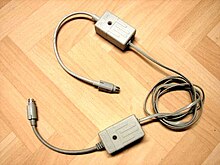LocalTalk
LocalTalk is a term from computer science and describes an outdated, proprietary network system from Apple .
specification
More precisely, it is a special implementation of the physical layer (according to the OSI model at level 1) for the AppleTalk protocol family.
LocalTalk specifies a two-wire line that uses the RS-422 connection of the older Apple Macintosh , which works at 230.4 kbit / s and allows a maximum packet size of 603 bytes; without data preamble and without trailer . The send and receive lines of the RS-422 interface are bridged in LocalTalk mode, so electrically, like Ethernet, it is a bus system, CSMA / CD is used for access control .
A splitter box is used for the wiring. On the one hand, it contains galvanic isolating elements in order to avoid equalizing currents between the individual stations in spatially extended networks; on the other hand, it provides two plug connections in order to interconnect several workstations to form a computer network . The ends of the network segment thus formed were automatically terminated .
A single LocalTalk network segment can be up to 300 meters in length. We recommend operating a maximum of 32 devices per segment.
LocalTalk was originally called AppleTalk Personal Network and worked with a shielded twisted pair cable and a three-pin mini-DIN connector. The devices were connected in a daisy chain similar to Thin Ethernet .
The printer of Apple were compatible Mac-at least with an optional, only for LocalTalk imaginary RS-422 interface as standard. In order to be successful in this market segment, other manufacturers have also equipped their printers with suitable interfaces.
When transferring files via AFP , the transfer rate is around 22 KBytes / s.
Over time, LocalTalk was not least because of
- the low speed and
- the processor load that increases with the number of nodes per line (including uninvolved stations)
surpassed by other technologies such as Ethernet or Token Ring in terms of speed and thus comfort.
With the introduction of the iMac in 1998 , Apple stopped supporting LocalTalk.
PhoneNet
A modification of LocalTalk was introduced by Farallon Computing under the name PhoneNet . A simple RJ-11 connection was used instead of the elaborate mini-DIN connector and simple telephone cables instead of the expensive twisted pair cables . The lower costs of the cable connections put PhoneNet in a better position than LocalTalk and even replaced it entirely in smaller networks.
With simple daisy chains, Phonenet allows lengths of 600 meters per line, in special configurations up to 1200 meters.
Another point to the spread of PhoneNet is the fact that existing telephone installations in the USA use the same connectors and thus cross-room networks can be created without cable laying work - hence the name “PhoneNet”. In the period that followed, other manufacturers published products based on RJ11 in order to save costs, some with manually installed RJ11 terminating resistors instead of the user-friendly automatic termination.
LocalTalk and IP
With the increasing importance of TCP / IP in computer networks, Apple offered a software called MacIP Gateway , which embeds IP packets in AppleTalk packets. MacTCP or OpenTransport on the client side have a mode in their settings to decapsulate these packets again and thus to use IP via LocalTalk, which is actually only suitable for AppleTalk. Also, Cisco has in IOS installed corresponding functions, even if LocalTalk is not supported by the routers themselves.
Due to the small maximum size of LocalTalk packets, the MTU of computers connected in this way is only 576 bytes.
Integration of LocalTalk in Ethernet networks
With the increasing spread of Ethernet networks in the 1990s, there was a need to integrate LocalTalk components such as printers or computers without an Ethernet interface (investment protection).
For this purpose, Apple offered the LocalTalk Bridge software , with which a Macintosh with both interfaces functions as a software bridge . This function can also be mapped with the Apple Internet Router , whereby this software maps a full-fledged AppleTalk router for many interface types.
Various manufacturers offered hardware-based Ethernet LocalTalk bridges, their advantages among others
- lower power consumption than a complete computer with software solution,
- location-independent than a complete computer,
- no unnecessary load on the computer through software bridging,
- fewer network failures due to incorrect operation (accidental switching off of the bridge computer)
were.
Some manufacturers also supplied bridges from Token Ring to LocalTalk.
The AppleTalk protocol stack
The AppleTalk protocols can be divided into several layers that form a protocol stack . The protocols can be classified in the ISO-OSI reference model as follows :
| OSI layer | AppleTalk protocol stack | ||||||
| 7th | AFP | PAP | |||||
| 6th | |||||||
| 5 | ZIP | ASP | ADSP | ||||
| 4th | ATP | AEP | NBP | RTMP | |||
| 3 | DDP | ||||||
| 2 | LLAP | ELAP | TLAP | FDDI | ← AARP | ||
| 1 | LocalTalk |
Ethernet - driver |
Token Ring - Driver |
FDDI - Driver |
|||
literature
- Gursharan S. Sidhu, Richard F. Andrews, Alan B. Oppenheimer: Inside AppleTalk, Second Edition . Ed .: Apple Computer, Inc. 2nd edition. Addison-Wesley Publishing Company, Inc., 1990, ISBN 0-201-55021-0 (English).
